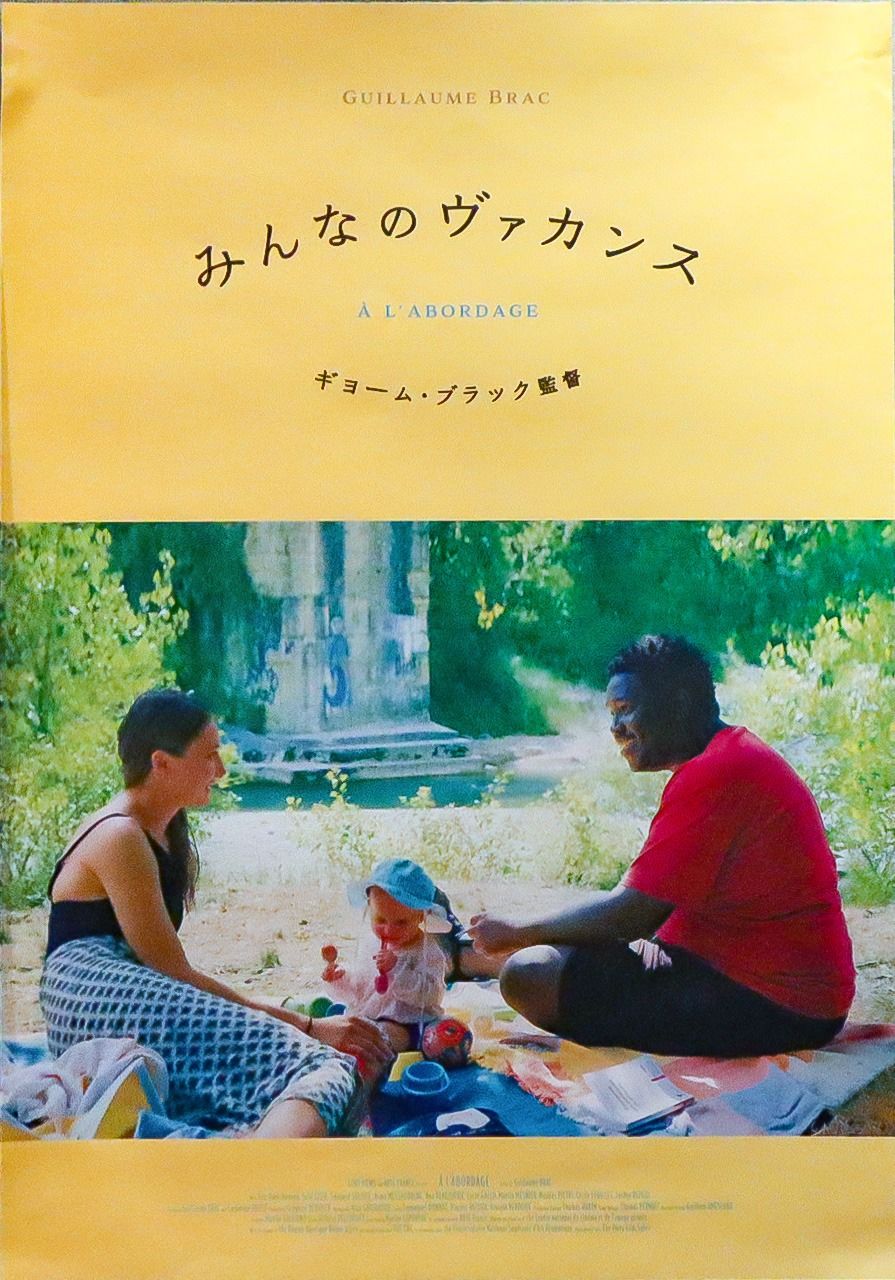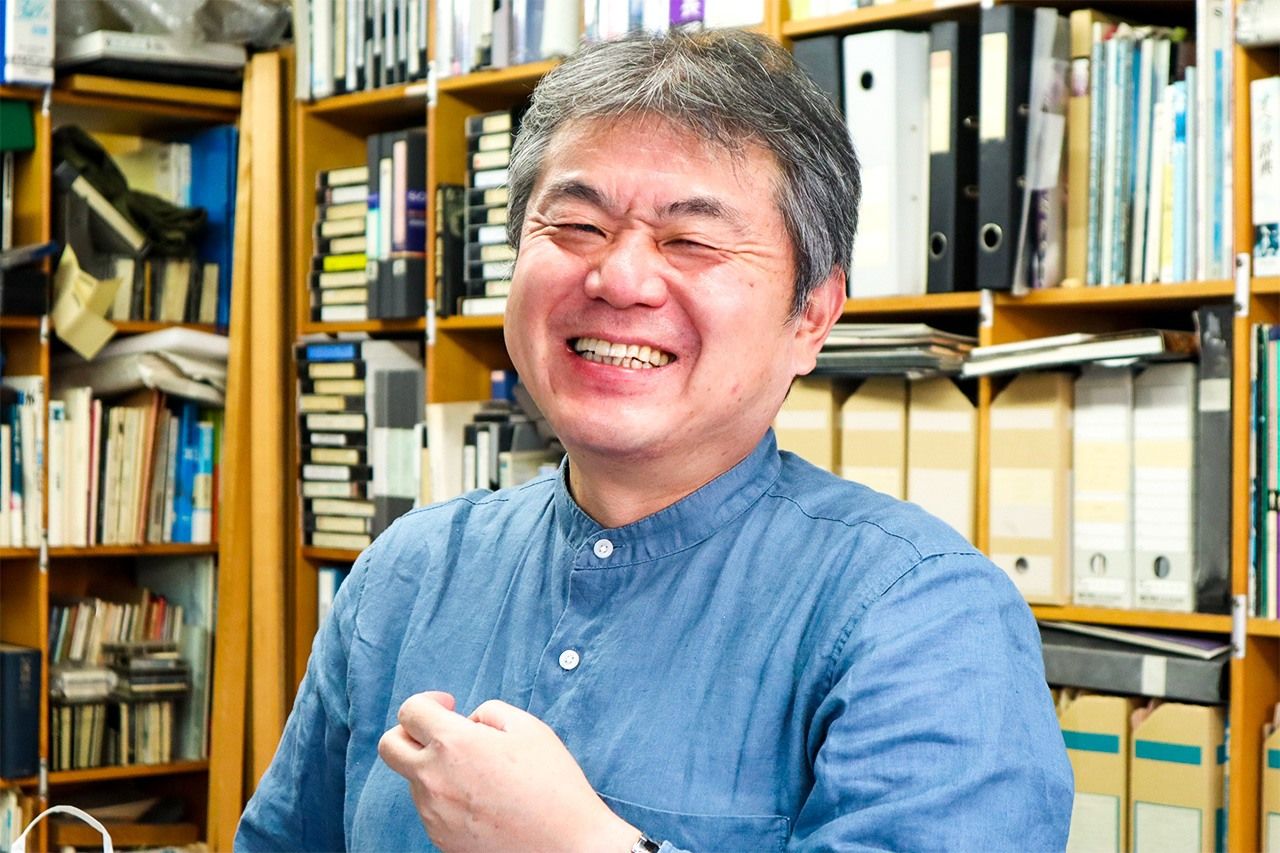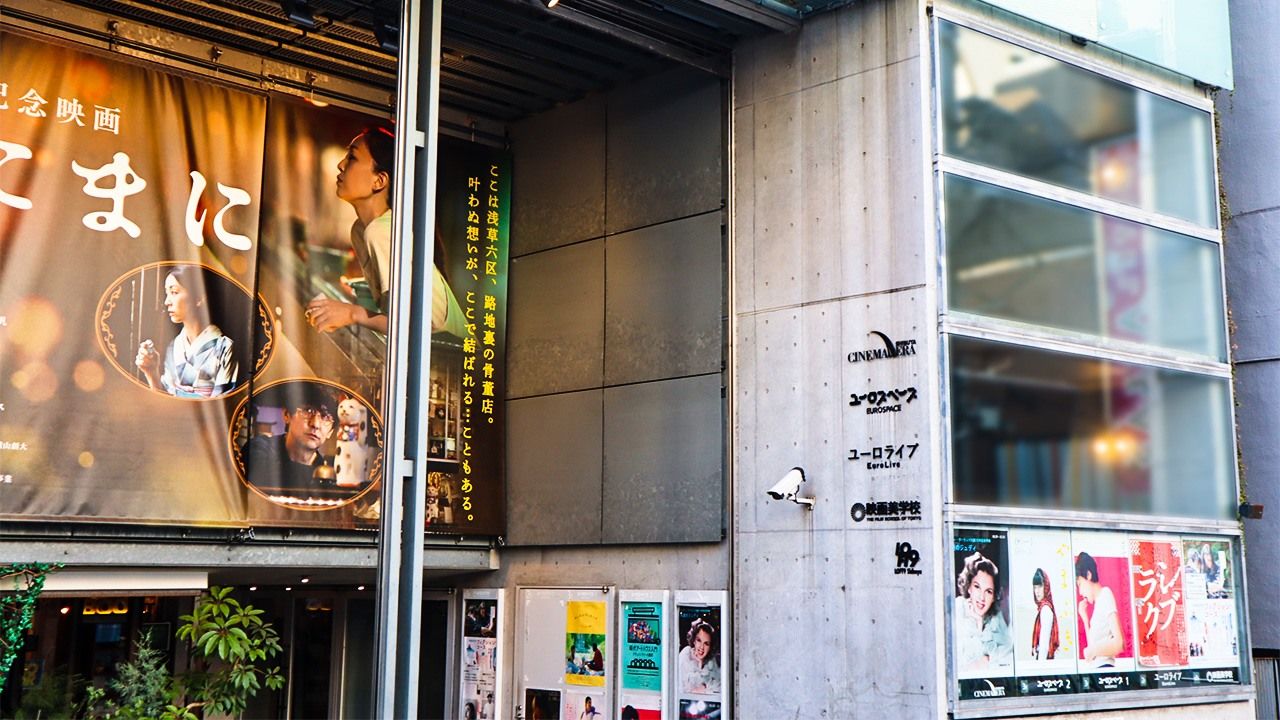
Japan’s Indie “Mini Theaters” Struggle to Survive
Culture Society Entertainment Art- English
- 日本語
- 简体字
- 繁體字
- Français
- Español
- العربية
- Русский
The Loss of a Valuable Concept
Iwanami Hall, which closed down in the summer of 2022, first opened in 1968 in Jimbōchō, Tokyo’s famous used-bookstore district. In 1974, it launched the Équipe du cinema project, which screened forgotten masterpieces of world cinema. These included a richly diverse range of films, from Satyajit Ray (India), Andrzej Wajda (Poland), and Theo Angelopoulos (Greece) to works by Japanese directors like Oguri Kōhei and Haneda Sumiko and masterpieces of third-world cinema.
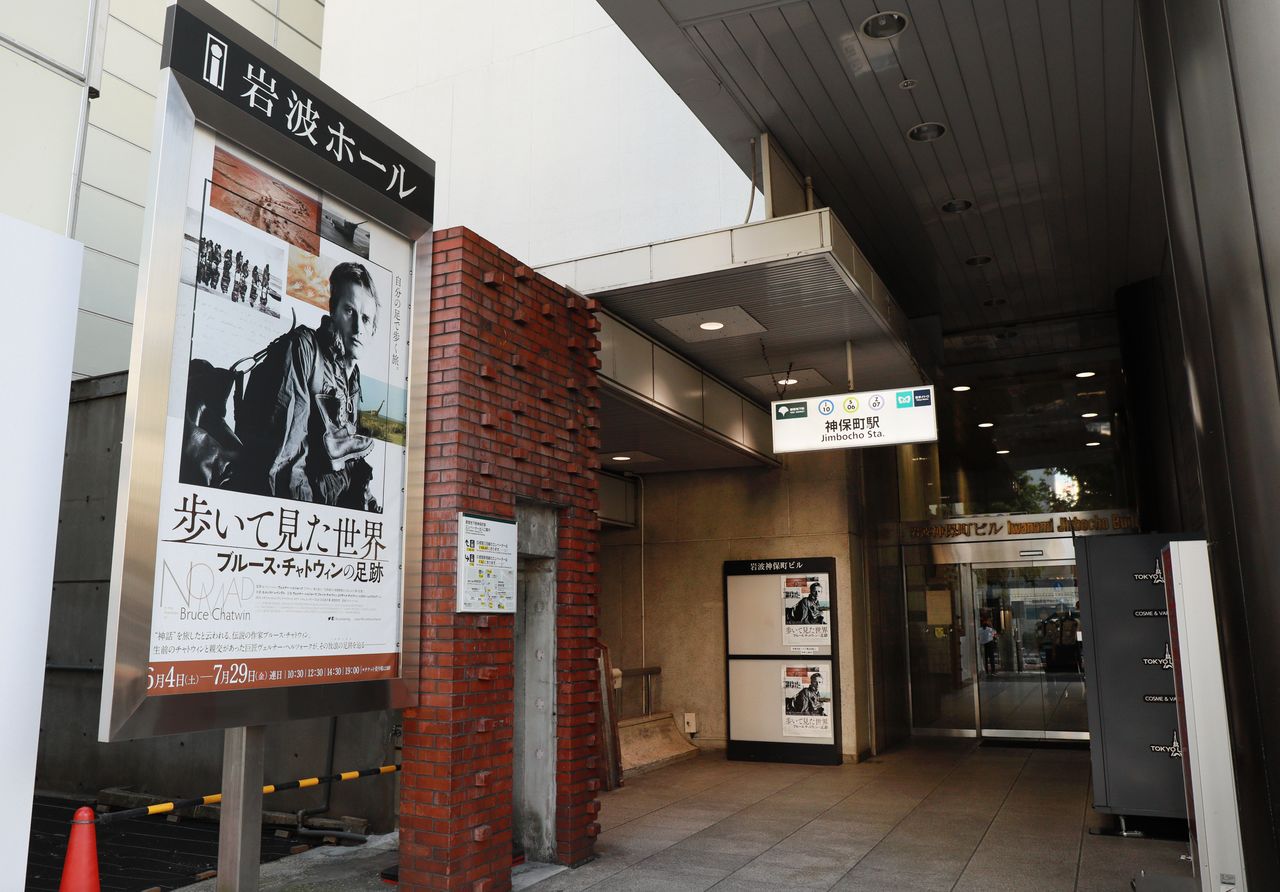
The entrance to Iwanami Hall on July 29, 2022. The last film to be shown was Werner Herzog’s documentary Nomad: In the Footsteps of Bruce Chatwin. (© Jiji)
In her remarks before the final screening, manager Iwanami Ritsuko looked back on the history of the hall, noting that the theater had screened 274 films from 66 countries and regions.
“It brought home to me that Iwanami Hall viewed cinema on a horizontal, global axis,” says Hōjō Masato, manager of the Eurospace theater in Shibuya. “My own approach is different. I think of it mostly along the vertical basis, in terms of directors. In selecting films by acknowledged masters of the artform, by mid-career directors, and by up-and-coming talents, I have always tried to find Japanese and international films that shed light on the past, present, and future of the cinema.”
“Combining those two approaches allows audiences to experience a wider range of films. The closing of Iwanami Hall brought home to me that this was what the mini theaters of Tokyo were all about. Now that horizontal axis has been lost. I feel a deep sense of loss. Even more than the place itself, we have lost a valuable concept that had been built up over decades of trial and error.”
Older Audiences Not Returning
When Tokyo’s first state of emergency was declared in April 2020, Eurospace closed entirely for a month, and even after it reopened, continued to operate for a time on restricted opening hours and with limits on the number of tickets sold for each screening.
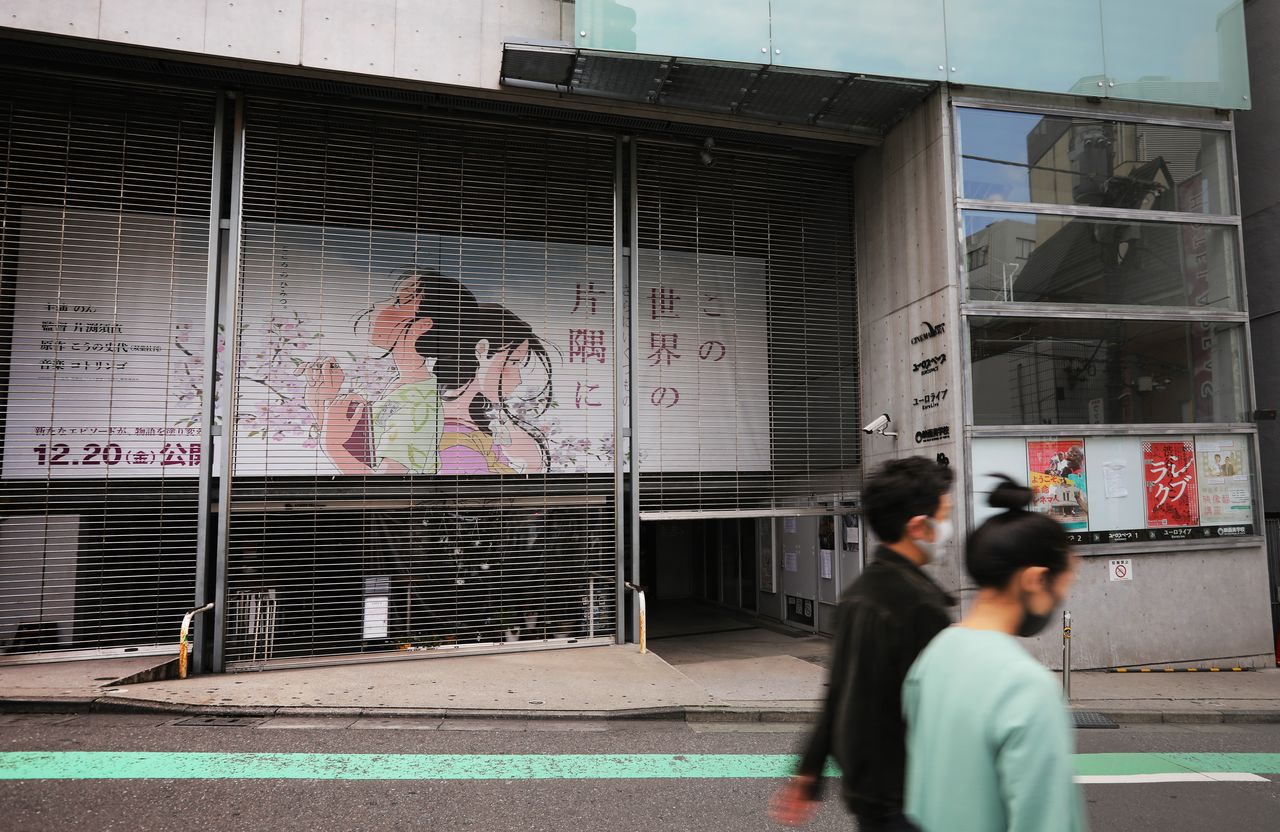
Eurospace closed for business during the pandemic. Photograph taken on April 23, 2020. (© Jiji)
“We have a reputation for attracting younger audiences compared to other mini theaters. And young people have now started to return in decent numbers. But older people still aren’t back to pre-pandemic levels. The size of our average audience has fallen by about 25 percent.”
Over the years, many mini theaters have focused on films likely to appeal to older audiences, and women in particular. Iwanami Hall was long supported by a faithful group of regulars, many of them older women. For theaters like this, already struggling to cope with the economic realities of a steadily aging population, COVID was the final straw. The theater’s takings dwindled, until management felt it had no choice but to close. Other theaters around the country face similar difficulties, for largely the same reasons. At the end of September, Theater Umeda, the best-known mini theater in Osaka, went out of business after 32 years.
The Age of the Mini Theater
In Japan, the term “mini theaters” refers to independent movie theaters with relatively small numbers of seats that are not under the direct control of the major production and distribution companies, with a tendency to show arthouse and other less mainstream films. Hōjō says that pioneers like Iwanami Hall and Eurospace took inspiration from Japan’s “cine-clubs.”
This movement eventually led to the opening of small independent cinemas: the first “mini theaters.”
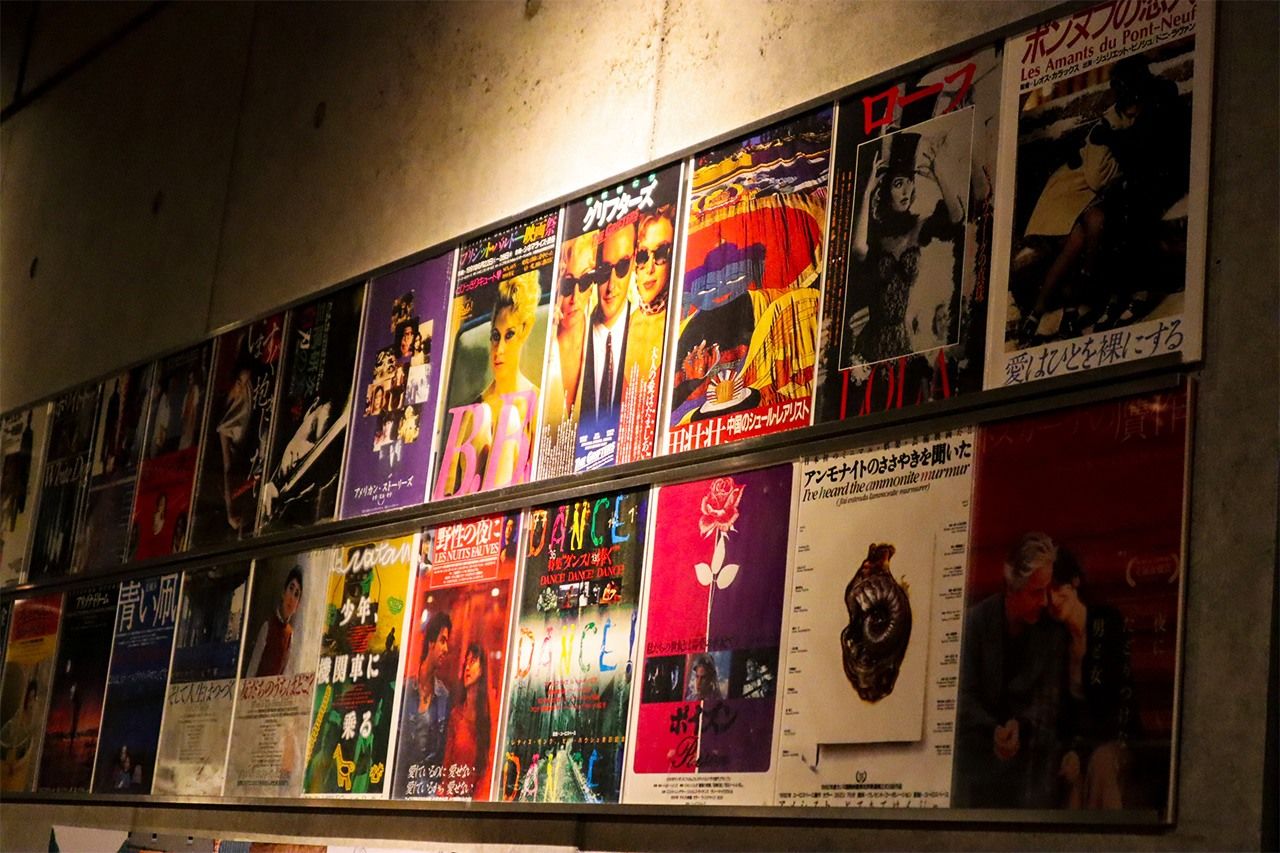
Posters in the lobby showing films screened at Eurospace. The theater has two screens with 92 and 145 seats, respectively.
Eurospace opened in 1982, and was quick to invite then-unknown directors like Leos Carax (France), Abbas Kiarostami (Iran), and François Ozon (France), to Japan. In 1987, it scored a big hit with the controversial The Emperor’s Naked Army Marches On. This documentary looked at a former soldier turned anarchist who became notorious for his protests against Emperor Shōwa, whom he blamed for the suffering he and his comrades had experienced in New Guinea. The film was a major success for Eurospace—one of the distinctive things about the theater is that it is involved not only in screening films but also in distribution, and often in production as well.
Starting in the 1980s, a succession of similar mini theaters opened in regional cities including Nagoya Cinematheque and Cinema Clair in Okayama. Major companies also started to get in on the act. Tōkyū Recreation opened Cinema Square Tokyo in Shinjuku, while distributor Saison Group opened Cine Vivant Roppongi, also in Tokyo. This was the age of the mini theater, a period that lasted until the turn of the millennium.
Save the Cinema!
In recent years, a number of factors have combined to make conditions tough for mini theaters, including the rise of multiplex cinemas, the increasingly diverse range of entertainment options available, and the popularity of video streaming services. As a result, many have disappeared. The onset of the pandemic in early 2020 came as a further blow to the industry, prompting several prominent figures including director Koreeda Hirokazu and actor Iura Arata to launch the Save the Cinema campaign. Hōjō was another of the backers. A petition calling on the government and Diet members for assistance for the beleaguered industry gathered more than 90,000 signatures.
At the same time, award-winning directors Fukada Kōji and Hamaguchi Ryūsuke launched a crowdfunding project called the Mini Theater Aid Fund. It raised more than ¥330 million in funding, which was shared among 118 theaters and 103 groups.
Hōjō says that this made visible for the first time the enormous enthusiasm and support that exists for mini theaters. “That we were able to raise so much funding gives me real hope for the future. It’s clear that people don’t want these theaters to disappear from the urban landscape.”
A Surprising Pandemic Hit from France
Hōjō had been looking for a new path to the future for the mini theaters since before the pandemic. He says his basic approach to compiling a program hasn’t changed. He still puts his focus on directors with something to say, from classics to young directors, and prioritizes well composed films with strong visuals, particularly in the case of works by young directors.
“In some ways, our relatively small size makes it easier for us to put on ambitious and riskier programs. Even with films that are not immediately accessible, we work to help audiences understand and appreciate them through director talk sessions and other events. We’re trying to become a venue for communication between filmmakers and audiences—something that is only possible because we are a relatively small theater.”
If the mini theaters are to survive, Hōjō says, one key will be to shift from the previous model of appealing primarily to older audiences and do more to draw younger people to the theater. “It’s difficult for the people running a theater and putting on films to stay enthusiastic unless the theater is the kind of place that young people want to come out and visit.” One film that was a surprising hit with young audiences during the pandemic was the French film À l’abordage (All Hands on Deck), a group portrait of an oddball trio of young people on a madcap road trip through the French countryside. The film’s gentle and offbeat humor was perhaps just what audiences were looking for during the dark days of the pandemic.
“This was the fourth of Guillaume Brac’s films we had shown, but it drew much larger audiences than we’d been expecting from those previous screenings. The film brought in not only core film fans, but university students on dates and groups of young friends—all kinds of people who wouldn’t normally come to see a film at Eurospace. The film has a natural warmth and generosity. It’s not pushy or preachy at all. It made me realize that even among young people there was a demand during the pandemic for films with that kind of reassuring feel-good warmth to them.”
Hōjō says his aim is always to build up a long-term relationship with a director.
“How it might happen: a distribution company in Japan might acquire the debut film by a young director at a film festival overseas, and we then show the film at our theater. My aim is to continue to build that relationship even after the initial screening comes to an end—talking to the distributor, and continuing to show the director’s subsequent works at our theater as his or her career develops. The success we had with Brac’s film was one example of the positive results that can come from this kind of approach.”
After showing their debut works, Hōjō is sometimes approached by Japanese directors looking for feedback on their second scripts. Often they incorporate Hōjō’s advice into the rewriting process and Eurospace screens the films once revisions are finished. One example of this process is Yūko no tenbin (A Balance), by director Harumoto Yūjirō, released in 2021. The film proved a hit and was later shown at the mainstream Toho Cinemas chain. The director is now at work preparing his third film.
Seeking Government Support
Since the Save the Cinema petition project, Hōjō has continued to petition for support for mini theaters from politicians and officials at the Ministry of Economy, Trade, and Industry and the Agency for Cultural Affairs. Recently he has been underlining the need for systemic support for cinemas from a longer-term perspective, which would include the introduction of public financial support. But he says it has been frustratingly difficult to get government officials to take his proposals seriously.
“The generation of Japanese directors now enjoying global acclaim—people like Koreeda Hirokazu and Hamaguchi Ryūsuke—they grew up watching films in mini theaters. Often the same theaters screened their own films later on, after they became filmmakers themselves. Without these venues, it would never have been possible for these directors to learn their craft. Now they have gone on to make films that move audiences around the world. But even this argument apparently isn’t good enough for government officials and bureaucrats. They’ve basically told me as much. One of them said: ‘That’s like saying we should support a fish shop because they sell good fish!’”
“When Bong Joon-Ho’s Parasite won the Academy Award, people in South Korea were delighted and felt pride in their country’s cinema culture. The same would surely be true in Japan: if our films won acclaim around the world, that would give people in this country happiness and a sense of pride. I try to argue that this is an industry that could have an enormous value for the country, but it just goes in one ear and out the other.”
One often cited problem is that there is no unified body responsible for the film industry as a whole. Film preservation and financial subsidies are the responsibility of the Agency for Cultural Affairs, while METI and the Ministry of Internal Affairs and Communications (MIC) also give out various subsidies under the Cool Japan policy, and support for the movie theaters themselves is the responsibility of the MIC. Other countries have a much more unified body in place. For example, France has the National Center for Cinema and the Moving Image; the Korean Film Council performs the same function in South Korea. These integrated organizations are responsible for all aspects of public and government policy and funding for the film industries in these countries. This makes it much easier to inject public funding than in Japan, and there are frameworks in place to return a share of ticket costs back into the industry.
“If a system of public financial support were put in place, I’m sure it would change the way people in the industry think about things. It would put pressure on us to come up with ideas and actions to show that we were worthy of that support.”
Hōjō is still looking for the right message that will convey this passion to the government and the taxpayers. He compares the mini theaters to museums as important places for learning in the local community. “I’m always trying to think of new ways we can contribute to the community, whether it be linking up with local schools to offer film appreciation for children, or holding screenings for people from minority groups.”
In 2003, the Agency for Cultural Affairs compiled a list of 12 recommendations to help the Japanese arts boost their profile overseas and policies for human resources training. Hōjō is now determined to lobby the Agency to come up with a new set of policy proposals specifically to promote the Japanese film industry.
“Twenty years ago, the Japanese film industry was in something of a slump and Western movies dominated the screens. There were no schemes in place to cultivate a new generation of artists and production staff were aging. The recommendations were made against that background. Conditions today are different, and there are lots of Japanese films being made. In that sense, the industry is quite vibrant. At the same time, a lot of problems have come to the surface, including sexism and poor working conditions. I think the time has come for us to work together with the agency to draw up a new set of recommendations. And my hope is that we can make sure that assistance for movie theaters is included as part of that.”
(Originally written in Japanese by Itakura Kimie of Nippon.com. Banner photo: Eurospace opened in Sakuragaoka, Shibuya, Tokyo, in 1982 and relocated to its current location in Maruyama in 2006.)

